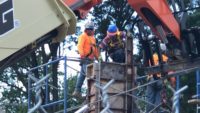EEOC Issues Anti-Harassment Guidelines for Construction

Laborers watch a colleague carry rods on a mixed-use project in northern New Jersey. New federal guidance offers approaches to prevent different forms of jobsite harrassment Photo: Richard Korman for ENR
The Equal Employment Opportunity Commission envisions general contractors taking the lead in preventing workplace racial and sexual harassment in the construction industry—part of recently released guidelines that call for committed anti-harassment leadership, clear procedures for complaints and effective ways to ensure they are followed-up and investigated.
The construction-specific details include recommendations to prevent taunts of someone performing a dangerous task, vandalizing a worker's toolbox or retaliations that include assignments to less desirable work shifts.
EEOC's new document, "Promising Practices for Preventing Harassment in the Construction Industry," does not have the force of law or add new mandates for employers, but it is the result of agency hearings that showed extensive harassment in construction, it says.
The document outlines a holistic approach in which project owners, crew leads and union stewards "clearly, frequently, and unequivocally message and demonstrate that harassment is prohibited."
Many construction employers have already adopted anti-harassment policies and procedures, but the EEOC document pulls together much of what is being done and goes further in outlining other steps they could take in the future.
For example, anti-harassment policies and practices should be required in contract bids, the commission states.
Measures should also include a discipline policy that is "prompt, consistent, and proportionate to the severity of the harassment or related misconduct, such as retaliation," the EEOC document states.
Bystander Intervention Training
Among prevention steps foreseen for general contractors is bystander intervention training, which the document says "typically enables bystanders to recognize problematic behaviors, motivates them to step in, conducts skills-building exercises to provide [them] with the tools and confidence to intervene, and provides [them] with resources they can call upon [to] support their intervention."
The training could include interventions such as "rallying others, including those in positions of authority, to intervene and checking in with the person being harassed."
An anti-harassment policy, EEOC wrote, should include a "clear description of prohibited conduct, with examples tailored to the work environment, such as taunting tradeswomen when they are performing a difficult or dangerous task, or vandalizing the toolboxes or personal protective equipment of Black workers."
"Certain conduct may be more likely to constitute unlawful harassment when it occurs in high-risk environments like construction," EEOC continued.
The commission also makes specific recommendations for unions to commit to harassment-free workplaces, including "consistently abiding by a commitment to preventing and remedying harassment in their governing documents and in negotiated workplace agreements."







